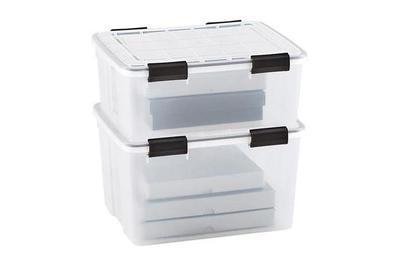
Clothes moths don’t care who you are or how much you love your clothes. They will find a way into your closets and quietly desecrate your garments.
Adding insult to injury, clothes moths (or, more precisely, their larvae, which we’ll get to later) prefer fibers of animal origin, including wool, mohair, cashmere, fur, and feathers—in other words, the expensive stuff and, in many cases, the vintage-heirloom stuff that has perhaps been sitting forgotten in an attic for who-knows-how-long.
The good news is, according to our research—which includes interviews with experts ranging from an entomologist to a world-class textile conservator—a number of simple and mostly inexpensive strategies that don’t involve pesticides (such as mothballs) or exterminators can thwart moths and their fabric-munching larvae if you act quickly and thoroughly at the first sign of trouble. It’s a three-step process: Identify the culprit, clean everything, and then take precautions against future infestations.
Identify before panicking
Start by identifying whether you actually have clothes moths. According to the Smithsonian Museum Conservation Institute, many other bugs feed on clothing but are easier to kill, including carpet beetles, hide beetles, and larder beetles. Beetles tend to have a relatively long life cycle (PDF), making them simpler to eliminate before damage occurs. Additionally, their grain-of-sand-sized eggs can easily be sucked up by a vacuum, whereas moth eggs are smaller and covered in an adhesive layer. (In either case, the treatment plan is the same.)
But even the sight of a moth isn’t a guarantee of infestation. Jason Dombroskie, manager at the Cornell University Insect Collection and the university’s Insect Diagnostic Lab, told us in an interview that most moths people find in the home are actually feeding on plants. Anything longer than 1 cm is likely not eating your clothing.
Only two moth species can damage your textiles: The casemaking clothes moth (Tinea pellionella) and the webbing clothes moth (Tineola bisselliella) most commonly infest clothing (PDF). Both are only about 1 cm long and yellow or grayish in color.
Once you’ve identified the moth, you’ll need to check your clothes for damage. Killing all the flying moths won’t solve the problem because it’s their babies that do the actual damage. Moth larvae are particularly attracted to dark, warm, humid spaces, as well as dirty clothing (especially unwashed items that may have lingering body oils or food residue). If you aren’t sure whether moths caused the holes in your clothing, one way to tell is that some larvae leave behind a web that resembles dried snot.
Clean up
After you’ve confirmed that you have clothing moths (or any cloth-eating bugs), take the following steps to clean your clothes and closet:
Discard particularly infested items. If the clothing is extremely damaged, it may be impossible to repair. No matter how much you loved it, you’ll love getting rid of the infestation more.
Thoroughly clean the clothes you do keep. Dry cleaning is the most effective method of killing moth larvae, and it’s worth the expense for wool sweaters and jackets you don’t want to risk ruining. You can also wash clothes on hot (water over 120 °F, according to Ajoy Sarkar, professor of textile development and marketing at the Fashion Institute of Technology). Read the labels, though, as many wools shrink and felt if agitated at such high temperatures. If you have a non-agitating shelf/rack in your dryer, that would be a good alternative for killing moth larvae on woolen clothing.
Clean your closet. Thoroughly vacuum your closet. Moths and larvae love dark corners and crevices. Remove the vacuum bag and discard it outside immediately, because it will probably be full of eggs and larvae. You may also consider using a dry cleaning service or a carpet steamer to do a deep clean of any rugs made of natural fibers.
Air, heat, or freeze items you don’t dry-clean or wash. A combination of sunlight and vigorously brushing the infested items can kill moth eggs and larvae. But this can be dirty work; expect to get grimy, and take care not to track eggs or larvae back into your home. You can also heat-treat woolen items by placing them on trays in an oven set to the lowest heat (at least 120 °F). Avoid doing this with any clothes that have beadwork or plastic, which can melt. Freezing can also work, but only if the change from warm to freezing is abrupt (70 °F to 0 °F), noted Dombroskie, and you must leave the clothes in the freezer for at least 72 hours once they reach freezing temperatures. Even then, the freezer may not resolve an infestation.
Protect yourself from future infestations

Wirecutter senior product manager, Alex Vaughn, once lost “a selection of gorgeous hand-me-down sweaters” to a moth infestation. Ever since her devastating sweater loss, Alex claims she has “over-indexed on prevention,” but her commitment to avoiding another scourge on her sweaters is the right instinct. “Monitoring and cleaning the storage area regularly may seem like very basic advice,” explained Kira Eng-Wilmot, textile conservator at Cooper Hewitt, Smithsonian Design Museum, “but [they] are very important parts of our preventative plan against pests.”
Take care to store clothes made of wool, fur, or feathers in tightly sealed plastic storage bins or compression storage bags. Place suits, dresses, or other hanging clothes in garment bags, sealed and without holes (tape over any seams or joints). Avoid fabric containers, which moths can eat through. Airtight storage isn’t the only solution, though. Keeping your closets open and moving clothing around frequently will help prevent moths from wanting to hang around in your closet, because they hate light and movement.
Sturdy construction and better materials give this versatile bin an edge over the competition. We recommend the 41.2-quart size for under-bed storage, but the smaller or larger sizes will also work for closets.
Buying Options
Although cedar and other herbal scents can repel moths, Dombroskie expressed uncertainty about those methods’ efficacy. He mentioned that cedar chests are effective, but primarily because of their airtight seals. It’s unlikely that the cedar linings on their own would be effective against moths or their larvae. In any case, cedar oils lose volatility as the wood ages.
Mothballs, although effective, should only be used as a last resort. If you go this route, Sarkar recommends sticking strictly to the manufacturer’s guidelines for the amount to use: “If you go less than that you will not have enough concentration to kill the larvae.”
Additionally, mothballs are a pesticide, and breathing large amounts of the fumes can make you pretty sick. Keep them out of reach of kids and pets (you don’t want either mistaking mothballs for candy), and sealed inside storage bins. If the health risks aren’t enough to dissuade you, consider that the chemicals in mothballs can soften plastic, which severely limits your storage options.
If you have webbing clothes moths, take the final step of adding pheromone traps. These can kill adult male moths, preventing them from mating and reproducing. The traps are specifically designed for webbing clothes moths and don’t work for the less common casemaking moth. This step can’t completely control an infestation but, along with killing the males, it can indicate whether you have a moth problem.
Keep an eye on your sweaters and other wool clothes for signs of moths, and be diligent about keeping them clean. Likewise, wash any vintage or used clothes you buy before storing them.
If all else fails, get help
Bug issues often don’t resolve themselves on the first try. When they don’t, keep in mind that hiring a pest-control operator is often the next best step.
Sources
1. Jason Dombroskie, manager at the Cornell University Insect Collection and coordinator of the Insect Diagnostic Lab, phone interview, March 15, 2018
2. Ajoy Sarkar, associate professor of textile development and marketing at the Fashion Institute of Technology, phone interview, March 15, 2018
3. Kira Eng-Wilmot, textile conservator at Cooper Hewitt, Smithsonian Design Museum, email interview, March 16, 2018
4. Insects and Wool Textiles, Smithsonian Museum Conservation Institute, September 2006
5. Carolyn Klass, Beetles Infesting Woolens Factsheet (PDF), Cornell Insect Diagnostic Laboratory, 1972, updated 2013
6. Carolyn Klass & Prof. Edgar M. Raffensperger, Indian Meal Moth factsheet (PDF), Cornell Insect Diagnostic Laboratory, 1973, updated 2012
7. Carolyn Klass, Clothes Moths Factsheet (PDF), Cornell Insect Diagnostic Laboratory, 1981, updated 2012
8. Gervais, J.; Luukinen, B.; Buhl, K.; Stone, D,. Naphthalene General Fact Sheet; National Pesticide Information Center, Oregon State University Extension Services, 2010
9. Charlotte Flint, Ahna Brutlag, Mothball Toxicity in Dogs, VCA Hospitals, 2014
10. Health Effects of Mothballs, National Pesticide Information Center, February 9, 2017
from Wirecutter: Reviews for the Real World https://www.nytimes.com/wirecutter/blog/how-to-get-rid-of-clothes-moths/?utm_source=rss&utm_medium=feed&utm_campaign=RSS%20Feed

No comments:
Post a Comment